Tiger Corporation “Survey on Electric Kettle Awareness”
[Tiger Corporation “Survey on Electric Kettle Awareness”]
New safety standards for electric kettles include the addition of the tipping over and running water test. The recognition rate is less than 30%.
More than half of the respondents were “burn reserve army” who do not follow the safety standards when using electric kettles.
Experts pointed out that “not having a fixed place to put the electric kettle” is a danger signal.
In order to prevent burns, the use of electric kettles with a “hot water leakage prevention*1 function when tipping over” is recommended.
Tiger Corporation (President: Yoshisato Kikuchi, Head Office: Kadoma, Osaka), a world leader in heat control technology and developer of electric kettles with an emphasis on safety, conducted a survey of 638 men and women in their 30s and 40s with preschool children aged six or younger to determine their attitudes toward electric kettles.
With the spread of electric kettles, burn accidents involving small children have become an issue, and in 2021, the “Notice of Partial Revision of the Interpretation of the Ministerial Ordinance Establishing Technical Standards for Electrical Appliances” added a tipping overflow test (the amount of hot water flowing out when tipped over must be 50mL or less). Electric kettles compliant with this standard*2 will not be able to be manufactured or imported after August 2024 if they do not meet the tipping over and flowing water test conditions of the same standard. *2 J60335-2-15(2021)
This press release introduces the points that should be noted to prevent burns from electric kettles based on the results of the awareness survey, as well as the Tiger electric kettles that have been designed to prevent hot water leakage from tipping over since their launch with a series of safety and security features such as “no steam/less steam” and “less spillage when tipping over*1.
*1 Even if the hot water supply lock button is locked, hot water may flow from the spout and cause burns if the kettle is tilted or knocked over.
Survey Summary
- Of those who had experienced a near-miss with burns, about 30% attributed the cause to the electric kettle.
- Of those who have experienced a near-miss with an electric kettle, about half were caused by the kettle tipping over.
- More than half of the “burn reserve army” responded that they “change the position of the electric kettle” after the water boils.
- Although more than 90% of the respondents are aware of the safety features of their electric kettles, the majority of them “have no idea” about the safety features of their electric kettles. Only 22.9% of electric kettle users have measures to prevent hot water leakage from tipping over.
Excerpts from Expert Comments
– Dr. Tatsuhiro Yamanaka, Director of Ryokuen Children’s Clinic and a leading pediatrician in the field of children’s accident prevention –
- Electric kettles without a hot water leakage prevention function are more likely to cause severe burns.
- Dr. Yamanaka pointed out that a factor that increases the risk of burns from electric kettles is “the lack of a fixed place to put the electric kettle.The reason for this is that “children place the kettle in places where they can reach it without being aware of it.
- One in three infants around the age of one has experienced burns, and burns from electric kettles occur frequently.
- “Please use an electric kettle with safety measures to prevent serious burns from leaking boiling water.
[Survey Overview]
Survey target: 638 men and women aged 30 to 40 nationwide with preschool children 6 years old or younger.
Survey method: Internet research using “Fastask” by JustSystems Inc.
Survey period: April 30 (Tuesday) to May 6 (Monday), 2024
*The results are rounded to the nearest whole number.
*When introducing the results of the survey, please include the following note: “Quoted from Tiger Corporation’s ‘Survey on Awareness of New Safety Standards for Electric Kettles'”.
94.3% of the respondents have had near-miss experiences with their own children in their daily lives.
Of these, more than 70% have had near-misses involving burns. About 30% of them had experienced a near-miss with an electric kettle as the cause.
- 94.3% of the respondents have had a near-miss experience with their own children, of which 70.4% had a near-miss experience with burns. Of these, 70.4% had had a near-miss experience with burns.
- 93.1% of the respondents said that they usually try to prevent their infant children from getting burned.
- More than half of the respondents had experienced a near-miss episode of scalding, with “almost touching a hot cooking utensil” coming in at No. 1. The second most common was “almost touching the steam from a rice cooker,” followed by “almost touching the steam from a rice cooker,” and the third most common was “almost touching, knocking over, or falling over an electric kettle.
- Of those who had experienced a near-miss with a burn injury, 29.0% attributed it to the electric kettle.
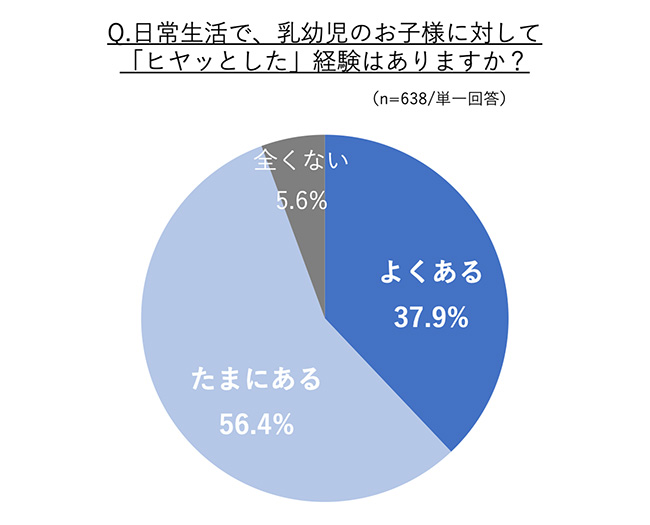
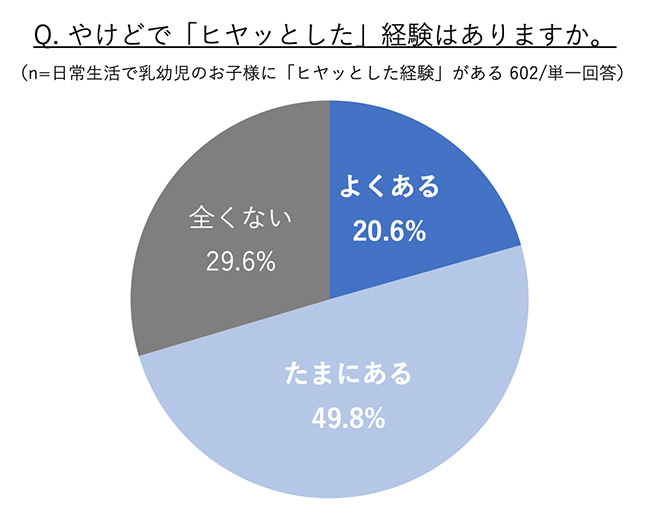
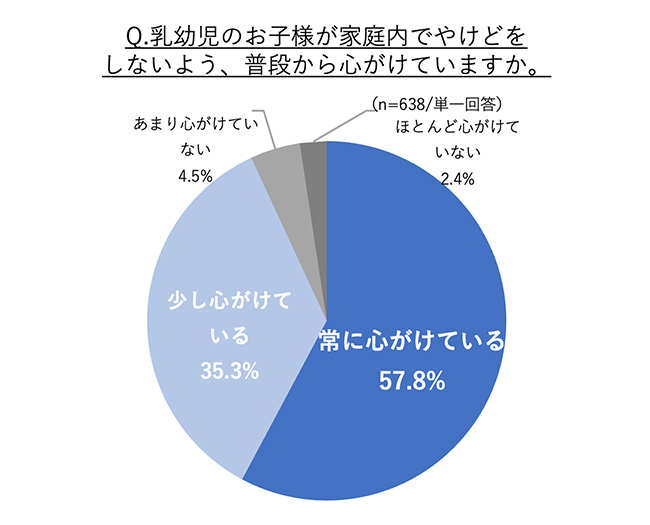
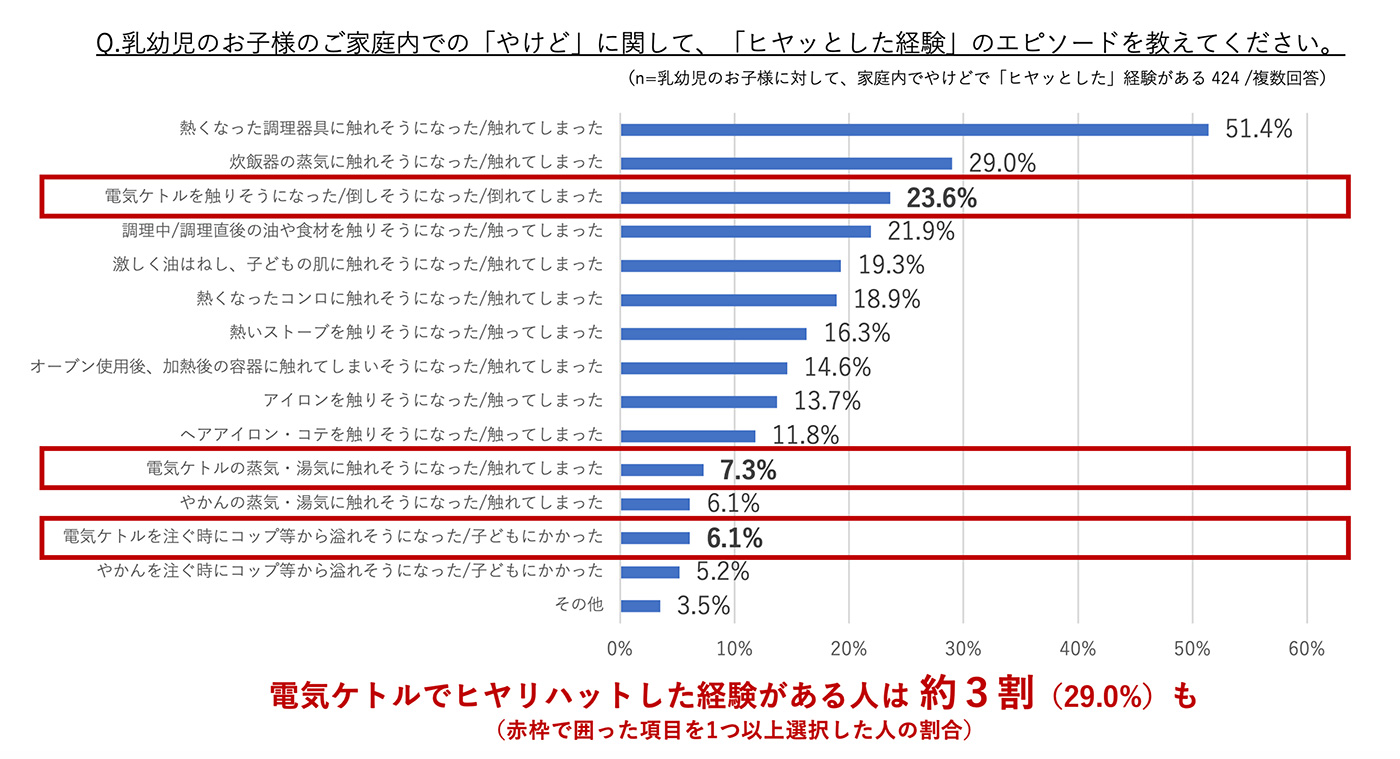
The No. 1 rule to prevent children from getting burned is “keep them away from the food while it’s cooking.
- The No. 1 precaution to prevent children from getting burned was to “keep them away from the stove while it is cooking. The number of respondents who said this amounted to 65.2%. The second most common practice was “keeping hot items out of reach of children” (57.5%). The third most common response was “not allowing children to approach the electric kettle when it is heating water,” but only about 30% of the respondents said this.
- In addition, only 23.8% of the respondents answered that they “keep cooking utensil cords out of the reach of children,” which can easily lead to burns from electric kettles.
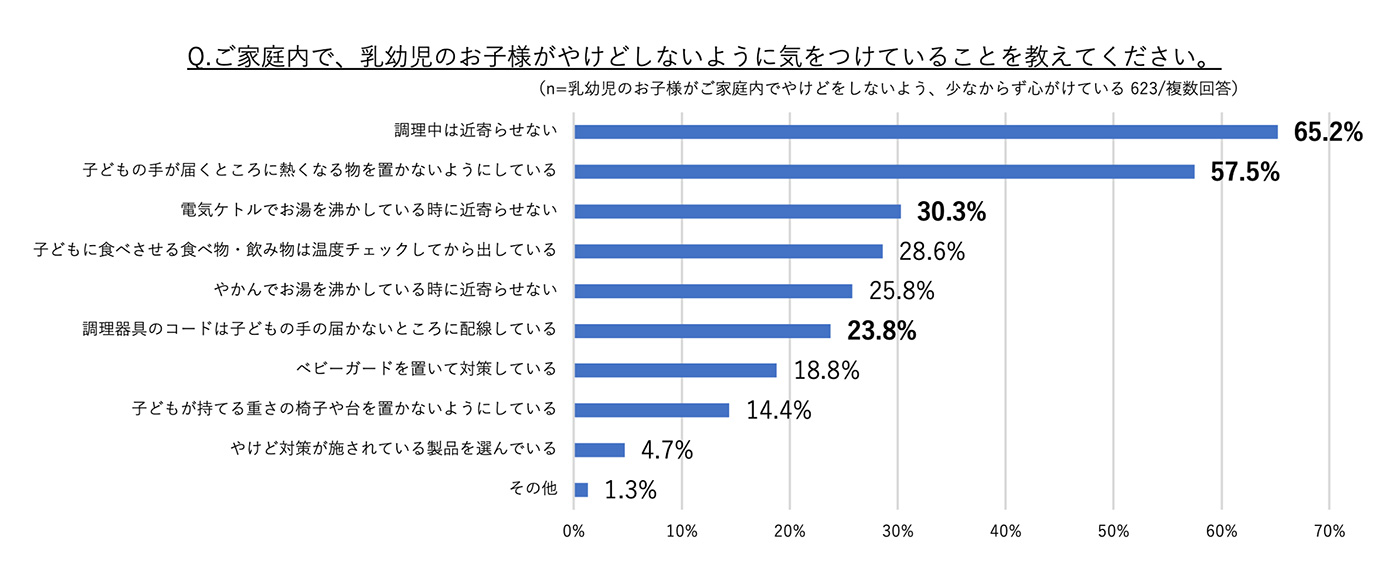
Of those who had experienced a child almost getting burned by an electric kettle, about half of them attributed the cause to the kettle “tipping over.
- When asked about episodes at the time, the most common were “children touching the hot surface,” followed by “children putting their hands over the steam,” and “spilling hot water when filling the kettle,” in third place.
- A total of 48.7% of the respondents had experienced burns due to the electric kettle tipping over.
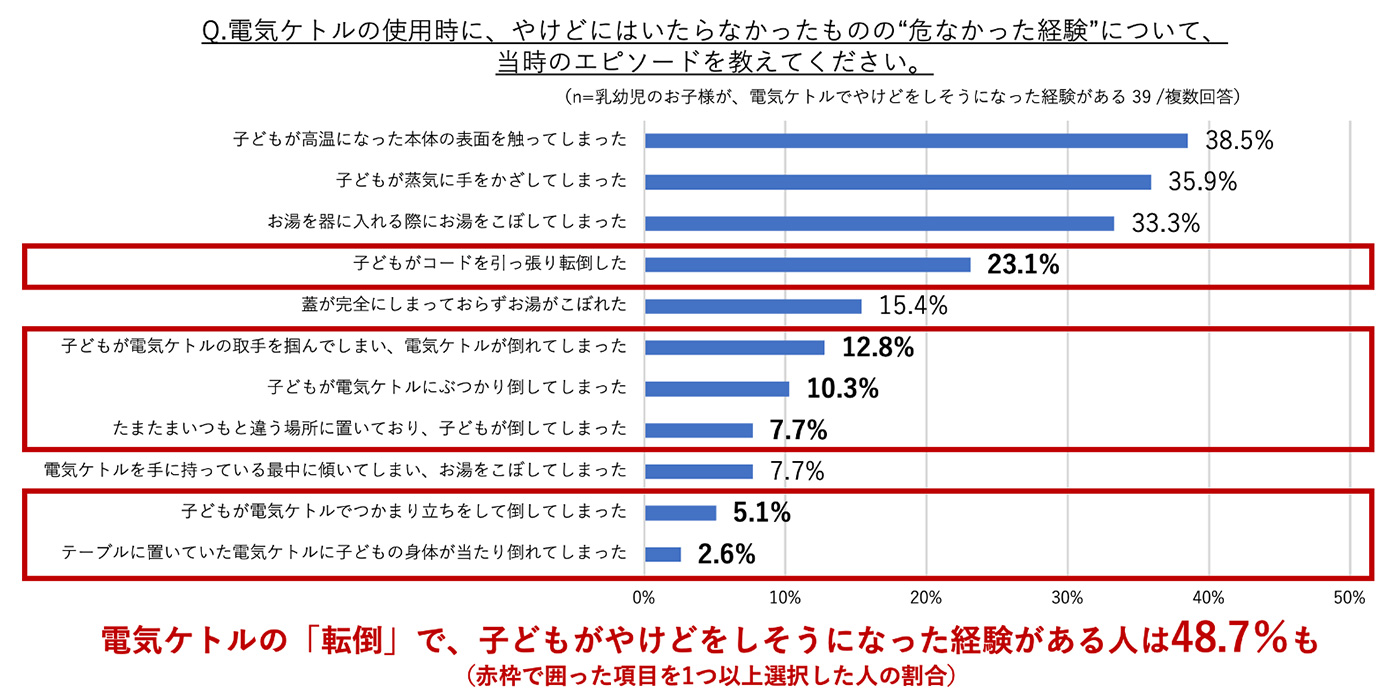
43.6% of those who have experienced children almost getting burned by electric kettles placed them “out of reach” of children. Electric kettles are placed “out of reach” of children. What are the reasons why burns occur even when the kettle is placed out of reach of children?
– More than half of the respondents said, “I don’t have a place to put the electric kettle” is not a good practice. More than half of the respondents are “reserve army” for burns. –
- When those who had experienced burns on their children were asked about where they had placed the electric kettle at the time, 43.6% said they had placed it “out of reach” of their children. The number of cases of near-misses was also high.
- When we asked Dr. Yamanaka why there was a risk of burns even though the electric kettle was placed out of children’s reach, he found that the most common reason for not using an electric kettle was “not having a fixed place for the kettle (changing the position of the kettle frequently). Even if the kettle is placed “out of reach of children,” in the majority of cases, burns occur when the kettle is temporarily repositioned during use.
- In light of the above, we conducted a survey of those who have changed the position of the electric kettle after the water boils, and the results showed that a whopping 51.8% of the respondents had changed the position of the kettle. It turns out that more than half of the respondents are “reserve army for burns.
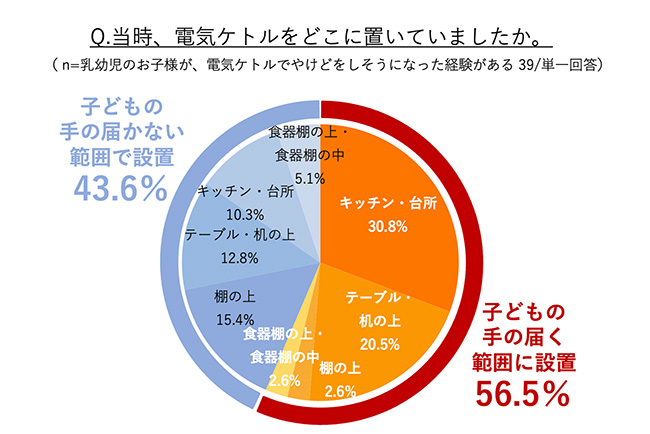
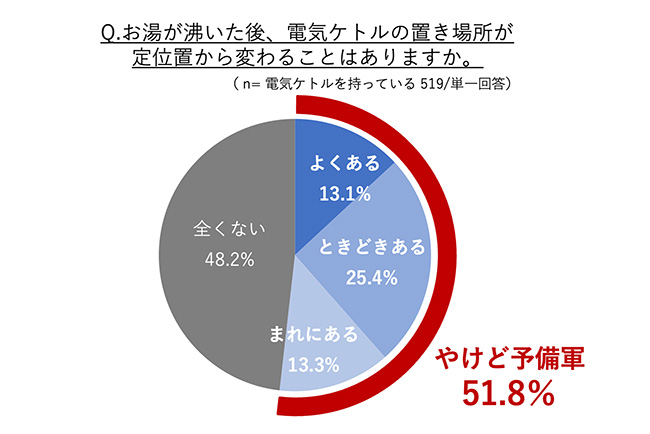
The largest number of respondents were “not at all aware” of the safety functions installed in the electric kettles they actually use. Only 22.9% of the respondents were aware of the prevention of hot water leakage by tipping over.
- When asked about the safety functions installed in their electric kettles, the largest number of respondents (31.8%) were completely unaware of them.
- When asked about the main factors that cause burns from electric kettles, only 22.9% of the respondents chose products with “prevention of hot water leakage from tipping over. This was followed by 31.2% who chose the “body does not get hot easily” function and only 18.7% who chose the “no or little steam” function.
- The results also highlight the tendency of respondents to have little interest in safety measures for electric kettles.
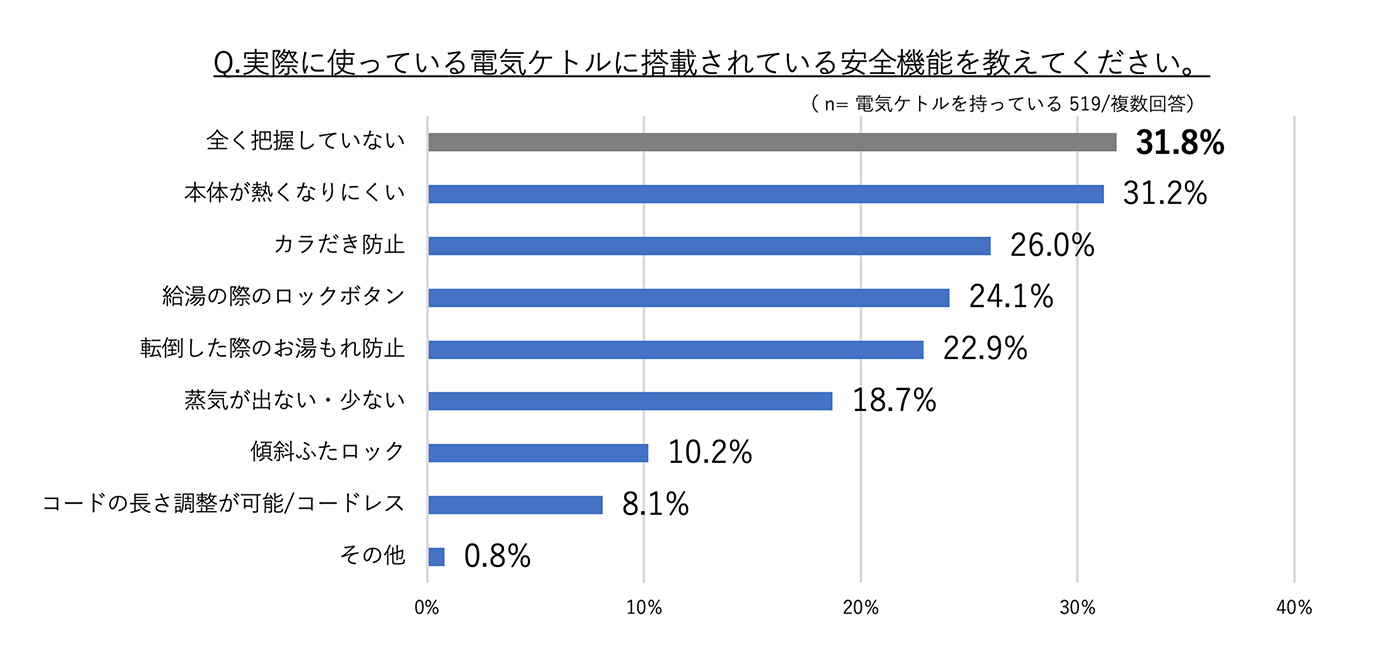
Only 23.7% of the respondents knew that “a new safety standard*1 for electric kettles has been added from 2021, which is a test for tipping over and running water (the amount of hot water that flows out when the kettle tips over must be 50 mL or less).
Only 23.7% of the respondents were aware that “a new safety standard for electric kettles has been added from 2021: the tipping over water flow test (the amount of hot water that flows out when the kettle tips over must be 50 mL or less). 1 J60335-2-15(2021)
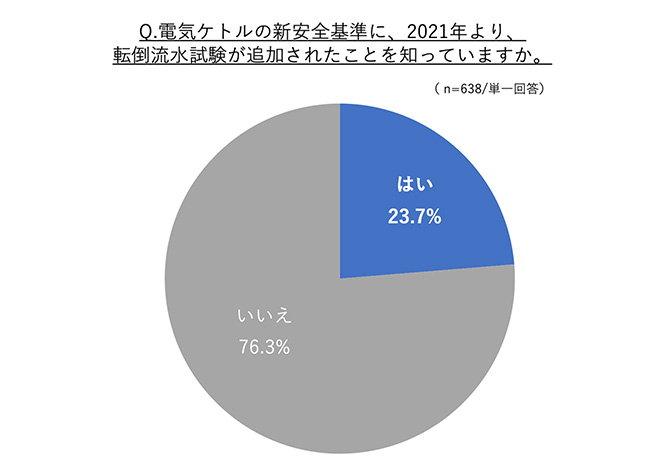
The results showed that only about 40% of the respondents had collected information on the dangers of burns to children and were aware of reports and news of burn accidents involving electric kettles.
The percentage of respondents who have collected information on the dangers of burns and accidents involving children was 42.7%, and 43.0% were aware of news reports and other information on burns and accidents involving electric kettles. Both of these results were only around 40%.
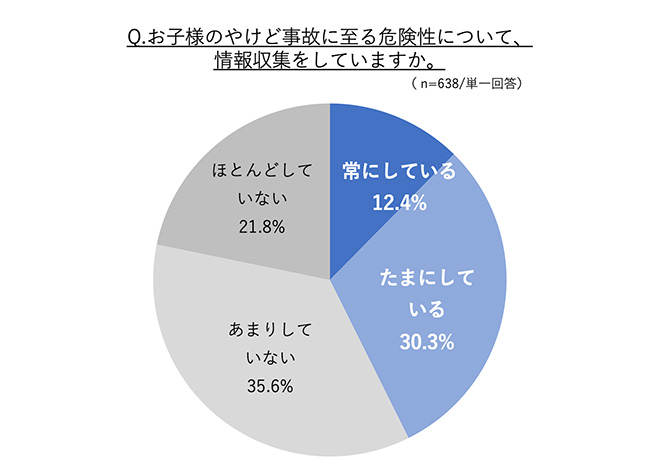
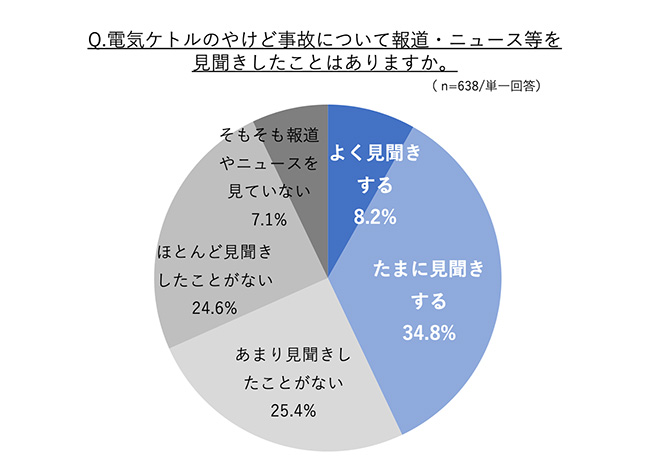
Comment from Dr. Tatsuhiro Yamanaka, Director of Ryokuen Children’s Clinic, a leading expert in preventing accidents involving children and a pediatrician.
– Recommend using an electric kettle with safety measures. Be especially careful when electric kettles are not placed in a fixed location. –
One in three infants around the age of 1 year has experienced burns, and there are many cases of severe burns from electric kettles.
It is said that one in three infants between the ages of 10 months and 1.5 years has experienced burns. There have been many cases of severe burns caused by electric kettles. In one past case, a child was crawling and bumped into an electric kettle, resulting in severe burns from the leaking boiling water.
People who “don’t have a fixed place to put the electric kettle” need to be especially careful. The reason for this is that they place it in a place where children can reach it without being aware of it.
One of the factors that increase the risk of burns from electric kettles is “not having a fixed place to put the kettle. Electric kettles can be easily placed “anywhere. People who do not have a fixed place for their electric kettle are more likely to put it in places where children can reach it without being aware of it. In many cases, children accidentally knock over the kettle and get burned by it.
It is important to always place the electric kettle in a fixed position and to make a habit of “never placing it anywhere other than the fixed position” even when using it.
As a result of the experiment, it was found that infants could receive burns requiring hospitalization within “only five seconds” after the electric kettle fell over.
In response to a number of burn accidents caused by electric kettles, we have conducted an experiment to measure the force with which an infant bumps into an electric kettle and an experiment to measure the force with which an electric kettle falls over. As a result, we found that the force applied to a crawling 10-month-old child when he or she comes into contact with an electric kettle is 133 newtons (13 kg). When a force of 133 newtons was applied to the electric kettles of various companies, all of them tipped over, and in the case of the type with a large hot water spout, the hot water spread to the extent that hospitalization was required (i.e., burns over 10% of the body surface) in only 5 seconds.
Based on this result, we recommend the use of electric kettles with a “fall over hot water leakage prevention function” in case they fall over.
Electric kettles can easily tip over, even with the force of an infant. In some cases, medical treatment is required for years.
When the amount of hot water in the kettle is small, the electric kettle becomes light and easily falls over even with the force of an infant. Because the water boils quickly, children can touch or knock over the electric kettle and get burned while the parent or guardian is away for a moment.
The burns can require years of treatment, including multiple skin graft surgeries, and can result in significant medical costs. Sometimes, the scars do not disappear, leaving functional impairments such as inability to fully extend the fingers. Parents feel guilty and heartbroken every time they see the scars.
I want parents to use electric kettles with safety measures in order to prevent children from severe burns.
I have been pointing out that “hot water leakage prevention functions should be standardized” at the national level. The revision of the new safety standard is exactly what I have been hoping for.
I believe that the frequency and severity of burns can be reduced by using electric kettles with safety measures such as those that are “spill-proof” even if they fall over and those that are “steamless” as per the new safety standard revision.
We hope that parents will please use electric kettles with safety measures to prevent their children from getting seriously burned by boiling water from electric kettles.
Profile of Dr. Tatsuhiro Yamanaka, a leading expert in preventing accidents involving children and director of the Midorizono Children’s Clinic, a pediatrician.

Tatsuhiro Yamanaka
Dr. Yamanaka graduated from the University of Tokyo Faculty of Medicine in 1974, and received his M.D. in 1987.
After serving as a lecturer at the Department of Pediatrics, Faculty of Medicine, University of Tokyo in 1987, Chief of Pediatrics, Yaizu City General Hospital in 1989,
and Director of Child Health Department, Kodomo no Shiro in 1995, he became Director of Midorizono Children’s Clinic (Yokohama City) in 1999.
In 1985, he took care of an eighth-grade girl who was sucked into a swimming pool drain, and began working on accident prevention effort
Currently, he is the Director of Safe Kids Japan, a non-profit organization,member of the Expert Committee on Prevention of Serious Accidents in Educational and Childcare Facilities, Child and Family Agency,member of Expert Council on Promotion of School Safety, Ministry of Education, Culture, Sports, Science and Technology,member of Product Test Analysis and Evaluation Committee, National Consumer Affairs Center,member of the Research Committee for the Prevention of Accidents at Schools, etc., Japan Center for the Promotion of Sports.
Tiger Corporation has sold approximately 8.5 million*1 electric kettles since 2008.
– Since its launch, TAIGER has been committed to safe and secure design, including a function that prevents hot water from leaking*2 when the kettle is tipped over. –
“Tipping over hot water leak prevention*2” to minimize hot water leakage [Compatible with all Tiger kettles]
Minimizes hot water leakage in the event of a fall. Minimizes the risk of burns due to hot water leakage.
*1 Cumulative domestic shipments from September 2008 to May 2024
*2 Even if the hot water supply lock button is locked, if the unit is tilted or knocked over, hot water may flow from the spout, etc., causing burns.
“Steamless*3″that does not emit steam [PTQ-A100] [PCK-A081] [PCK-T060] [PCJ-A082/A102]
Two Tiger proprietary technologies, (1) “Speed Steam Detection” and (2) “Steam Catcher Structure,” keep steam outside*3.
*3 Steam may be emitted from the spout if the water is heated when the main body is warm.
(1) Speed steam detection
Quickly catches the beginning of steam emission, so no excess steam is generated.
(2) Steam catcher structure
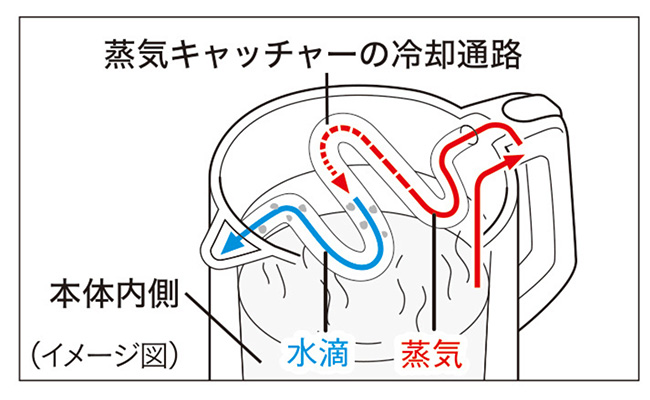
A “steam catcher” is installed inside the lid. Steam is cooled through a cooling passage in the steam catcher and forms water droplets, which are released from the spout when pouring.
Recommended electric kettles
Steamless electric kettle with temperature control function PTQ-A100
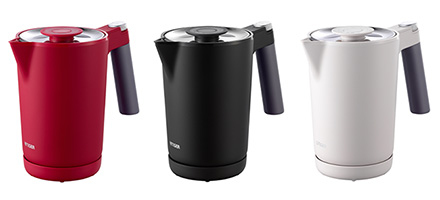
The pinnacle of Tiger electric kettles, combining a full range of functions and design features. The industry’s fastest*4 boiling time of approximately 45 seconds per cup.
Steamless electric kettle PCK-A081
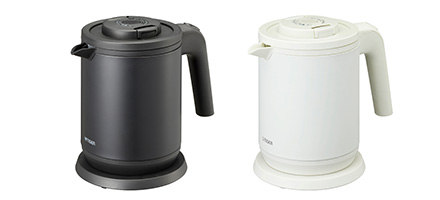
Combining safety and ease of use with a monotone matte texture and neat form that blends in with any space. The industry’s fastest*4 boiling time of approximately 45 seconds for one cup.
*4 Boiling time until power is automatically turned off in a household electric kettle as of June 13, 2024 at water and room temperature of 23°C and rated power consumption of approximately 140 mL for one cup (in-house measurement method; PTQ-A model with dial 100 setting).
Tiger Electric Kettle Product List Web Page
https://www.tiger-corporation.com/ja/jpn/product/list/electric-kettles/